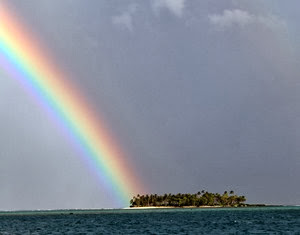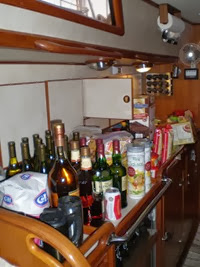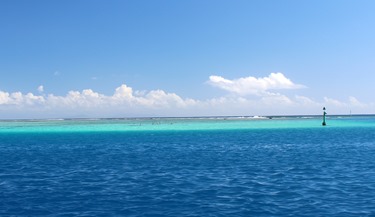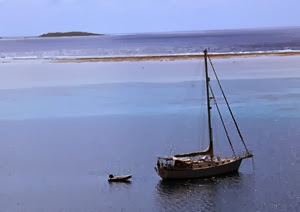
While we are in NO WAY experts after one year, there are some things we’d like to pass along that we have learned after sailing almost 10,000 miles out on the big blue ocean. In the interest of keeping it simple, I’m going to do bullet points on topics. If you have ANY questions, feel free to post a comment and I’ll try to get back to you when we have internet…
Food Provisioning
- Don’t go overboard on staples like rice, flour, milk, pasta or canned meat and vegetables. These items are available pretty much anywhere you go – even the smallest store will have most of them – so don’t bother wasting too much space on them.
- DO stock up on items you love that you know you won’t be able to get elsewhere. I am a total cheese-o’holick, so we brought a LOT of cheese and I buy more whenever we have the opportunity. I’m relieved to say we’ve never run out (not sure WHAT would happen if we did!!!). Stock up on what is important to YOU!
- Don’t bother stocking up on toothpaste, shampoo, soaps, etc. They are also available everywhere. Turns out people all over the world like to stay clean! Not sure why I didn’t think about that before we left…
- In Mexico you can find almost anything, so don’t feel like you need to buy a ton of stuff before leaving the states. If you make the jump across the pond to the South Pacific, things start getting harder to find and they are much more expensive. We provisioned VERY heavily in Mexico and it saved us a LOT of money in the long run (AND allowed us to eat well for a reasonable price!).
- If you drink, stock up heavily before leaving the states or Mexico as alcohol is VERY expensive pretty much everywhere in the South Pacific, but especially in French Polynesia. And don’t forget about your mixers! Tonic was available in larger ports, but only after some wide searches – even in Mexico.
- Bizarrely, junk food and sugary cereals are available in EVERY store (even the tiny ones) in the south pacific. It’s a pretty sad statement if you ask me – but I will admit to being glad to get a pretzel fix whenever I want one…

- Mexico – if you plan to winter in Mexico before making the jump to the South Pacific, do NOT plan to winter in the Sea of Cortez. We did a lot of reading, but never found this advice, so thought we should pass it along. While the the sea is a wonderful and beautiful place (can’t express how much we loved it there), December through March is NOT the time to be there. You will get constantly pinned down in 20-35 knot winds for days at a time. There is a reason cruisers leave for mainland Mexico by mid-December!
- If we had to do over again, we would spend less time in the Marquesas and WAY more time in the Tuamotos. While the Marquesas were nice, the anchorages can be rough and it all looks very similar after a while. Since you only have 90 days in FP, we would recommend 2-3 weeks in the Marquesas, 5-6 weeks in the Tuamotos and the remainder in the Society Islands.
- Do NOT miss Suwarrow!!! Out of everywhere we’ve been, this was by far a favorite spot and should not be missed. There is something magic about that place and we wish we could have stayed much longer.
- Skip America Samoa if you are only going there to provision. The cost to stay (we paid $167 and are US citizens!) completely offsets any money you save on what you buy there. If you absolutely MUST have your US type products, than make a stop, but don’t do it if you just want to save money. That said, we loved the Samoan people and the island itself was beautiful once you got out of the dirty and smelly Pago Pago harbor.
What to bring:
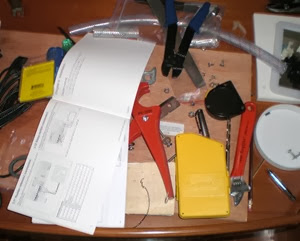
- SPARE PARTS!!! Brett took a lot of grief from everyone on how many spare parts we purchased before we left, but some of them have really saved our bacon (or the bacon on another boat that needed it). Even so, there were things we didn’t think of. So if you have the room, bring everything you can think of that might break.
- Lots of flashlights. You might even consider installing a flashlight in each area of your boat – you will be amazed at how often you need one and it’s great to have one no matter where you are.
- Tools – bring as many as you can in the room you have available. Think through every major system on your boat and what you would need to fix it when it DOES break.
- Buy LOTS of batteries if you have battery driven items. We were shocked at how fast we went through our AA’s. They also make great trading items.
- Bring lots of paper, pens and pencils for the kids in the islands. As we got past FP the kids were not asking for money or candy – they just wanted school supplies, which are very expensive to buy here. I can’t think of anything I would rather give away than something that will help a kid in school.
- Extra t-shirts are good for trading and gifts. Know that your own t-shirts will all end up stained and in tough shape as time goes on so having some extras is a good thing.
- LOTS of bathing suits – you’ll wear them out quickly and it’s something you need. Buy good quality swim suits – not cheap ones as they break down really fast in the sun and salt.
- Bring a light weight wet suit or full body micro suit. Even though the water is warm you get cold pretty quick when doing long snorkel trips. Also invest in quality snorkel gear.
- Various bug traps and bug bombs – ants, cockroaches, etc. Even when you are super careful it can still happen. While we have been lucky to not have any cockroaches (yet!), we know several (clean and careful) boats that do and they are really tough to get rid of if you don’t have the stuff to do it.
- Mosquito coils or candles and LOTS of bug spray as the mosquitos in some areas can be brutal.
- Extra printer cartridges – you can find them, but they are WAY more expensive than in the US. Make sure you store them in some sort of plastic as they will often dry up. It’s great to have a color printer to print a photo or two of a local you’ve friended – they love them!
- Lonely Planet (or similar) guides on anyplace you plan to go. Knowing something about the places your traveling in makes for a much richer experience.
- Stainless steel polish (to many brands to name one) and a stain remover (like FSR). Stainless does rust in the tropics and it will color your fiberglass pretty quickly if you don’t keep after it.
A washer/dryer installed on the boat. Laundry turned out to be a really big deal after leaving the wonderful services in Mexico. Not only has it been ridiculously expensive (we’ve paid as much as $20 US for one load, wash only!), but they don’t always come back any cleaner than they left. We do almost all of our own laundry on board and only send out towels and sheets, usually for wash only to keep the cost down. I can’t tell you how many hours I’ve wasted (with sore arms to boot) doing laundry. If we had installed one of the small washers available for boats, I would be a much happier gal.
Weather & SSB Radios
Do not leave home without installing an SSB radio. Sign up for either Winlink (free) or Sailmail (better stations for the South Pacific IMHO) and make sure you understand how to subscribe to weather files – both gribs and text. These will be unbelievably important to you at all times – you must know and understand how to get them and how to read them. Your safety depends on it. You should always look at the weather for several days prior to your departure and if it looks bad – don’t leave!
The added benefits of the SSB radio are you can join local nets to keep track of friends or to let people know where you are. Also great is the ability to keep in touch via email with loved ones at home when there is no internet. While internet coverage is fairly good in most places, there are definitely times when you won’t have it and will be very glad you’ve got your SSB.
Top 3 things that break down on cruising boats:
- Refrigeration
- Outboard engines
- Autopilots
Equipment Recommendations:
- The strongest autopilot you can afford to install in your boat. Out of all the things that break, the worst one that happens to MANY cruisers is losing your autopilot. I can’t tell you how many boats we know that have told us horror stories of having to hand steer their boats during long passages when their autopilot when out. Knock on wood, but we haven’t had any problems yet as we installed a hydraulic autopilot that was oversized for our boat. We’ve put that piece of equipment through some serious tests and I’ve never been so glad that we spent the money to upsize.
- Dual refrigeration systems. We have both engine driven and DC driven and both have failed us multiple times, and currently BOTH are not working (sigh). We’re hoping to have the parts for the DC one when some friends arrive to visit, but no clue when our engine driven one will be back online as we have a leak that we haven’t been able to identify. Hopefully the DC one will get us to New Zealand once we have the parts. Until then we have our food on several different boats that had some extra room. It’s amazing how other cruisers will come through to help when needed. Make sure your system is in great shape and bring lots of spare parts – especially brushes for the motor!
- Two outboards – one large and one small. Not only is it great to have a backup outboard if one goes down, it’s great to have options. When we know we’re just cruising around a small anchorage we use our putt putt. Not only does it use less fuel, but it’s lighter (easier to move) and you don’t need the big fuel tank in your dinghy. But when we have to go longer distances, it’s great to have the big dog – it gets us up on a plane and we fly across the water, covering long distances in no time.
- Get a good dinghy with a hard bottom and a nice v-shape in the front. This is your CAR! You will be spending a LOT of time in this car and it’s shape is very important. The v-shape in the front (preferably coming up at a nice sharp angle) will keep the water out of the dinghy when it’s rough out and make for a dryer ride. If only we’d known that before we left…..I wouldn’t have to listen to Brett curse our dinghy on a regular basis (sigh). Also consider having dinghy chaps made to cover it as it will prolong the life of your “car” considerably.
- A good wind generator is worth its weight in gold. Same for solar panels. It’s free energy. Enough said.
- Lot’s of low draw fans. You simply can’t have enough of them. Put them everywhere you spend time – especially by the bed, galley and main salon. You WILL be hot in many locations and you will be very glad you have them. I’m sitting in front of one right now in fact!
- A Rocna anchor – I know this will provoke plenty of arguments, but I firmly believe the Rocna is THE BEST anchor on the market. It holds beautifully in pretty much every anchorage we’ve been in – sand, mud, rocks, you name it. It has awesome holding ability but still comes up easily – even after 4 days of 30+ knot winds. It has gotten us through some sleepless nights at anchor while everyone around us was dragging. I know they are expensive – but they are worth every freaking penny.
- Having a wifi booster on board is great – lets you get internet in the comfort of your own home instead of having to go to the local internet café. Not a “must have”, but rather a “nice to have”.
- Take the time to have a big sendoff party. It doesn’t have to be fancy (ours was BYOB) and it allows you to say goodbye to all the people you care about along with giving you a great memory to hold dear during your final days at home and all the stress that comes with it.
- Accept that you will be VERY stressed out during those final weeks trying to get through your check list. Brett’s blood pressure was off the charts during this time – but thankfully went right back down after we left.
- Have someone at home to help manage your affairs and be a home base. Many things (insurance, credit cards, banks, etc) want you to have a US address (no PO boxes allowed) so this really helps. If you trust them enough to do a power of attorney, I would recommend that too as we have had to use that once already.
- Put your affairs in order. Make sure your family knows what you want if you are hurt (aka a “living will”) and create a will so that it’s clear what should happen if the worst happens to you. Hopefully you won’t need it!
- Make sure your health insurance includes a healthy amount of evacuation insurance to fly you to a better hospital. While we haven’t needed it ourselves, we’ve heard of a few folks that have.
- LEAVE! Sometimes just leaving the dock is the hardest part, but there comes a time when you have to accept that everything won’t be perfect but it’s just time to go anyway!
- Be prepared to go through a BIG adjustment period – even if you’ve lived aboard for years. Leaving all your friends and family behind for the unknown is not an easy thing and it takes some getting used to. Let yourself have time to adjust.
